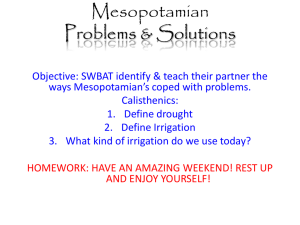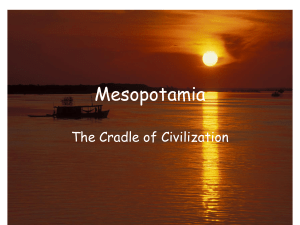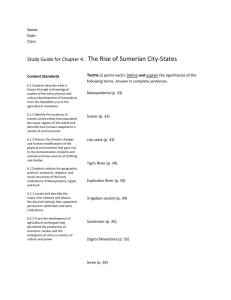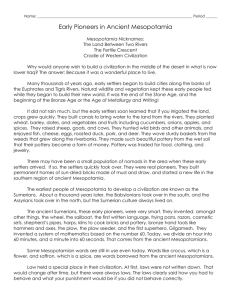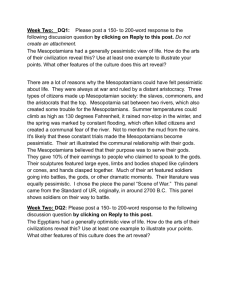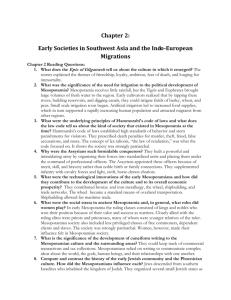Mesopotamian Civilization Worksheet: Exercises & Key Terms
advertisement
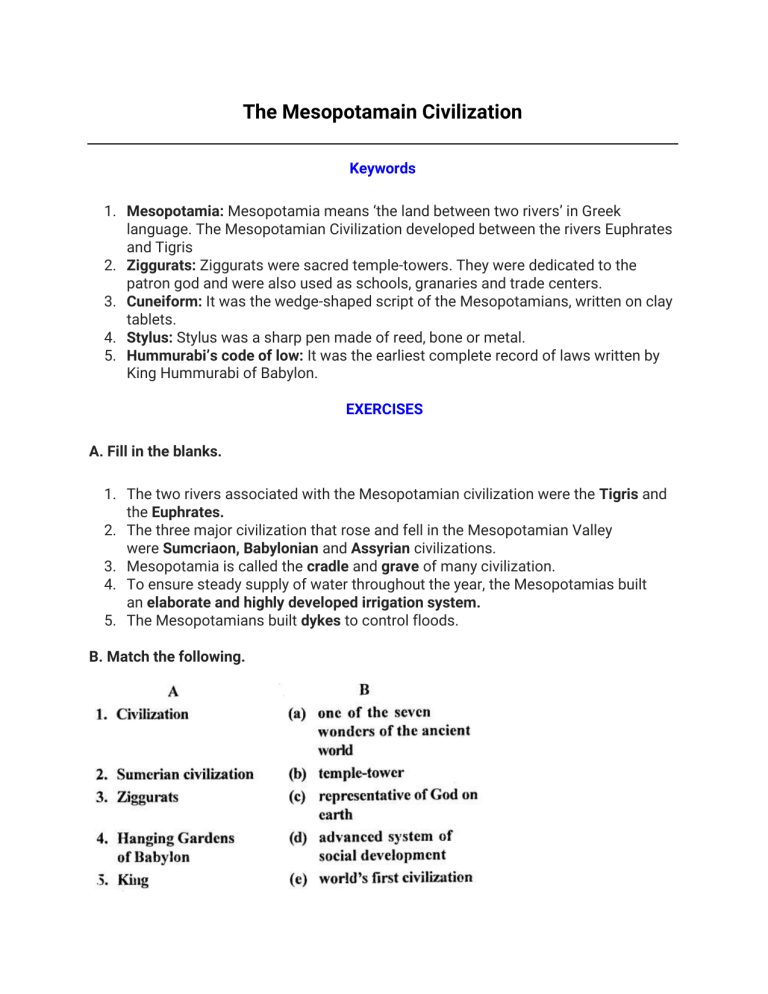
Downloaded from https://www.ncertbooksolutions.com/ The Mesopotamain Civilization Keywords lu t so EXERCISES io ns .c om 1. Mesopotamia: Mesopotamia means ‘the land between two rivers’ in Greek language. The Mesopotamian Civilization developed between the rivers Euphrates and Tigris 2. Ziggurats: Ziggurats were sacred temple-towers. They were dedicated to the patron god and were also used as schools, granaries and trade centers. 3. Cuneiform: It was the wedge-shaped script of the Mesopotamians, written on clay tablets. 4. Stylus: Stylus was a sharp pen made of reed, bone or metal. 5. Hummurabi’s code of low: It was the earliest complete record of laws written by King Hummurabi of Babylon. oo k A. Fill in the blanks. ht tp s: //w w w .n ce rtb 1. The two rivers associated with the Mesopotamian civilization were the Tigris and the Euphrates. 2. The three major civilization that rose and fell in the Mesopotamian Valley were Sumcriaon, Babylonian and Assyrian civilizations. 3. Mesopotamia is called the cradle and grave of many civilization. 4. To ensure steady supply of water throughout the year, the Mesopotamias built an elaborate and highly developed irrigation system. 5. The Mesopotamians built dykes to control floods. B. Match the following. Downloaded from https://www.ncertbooksolutions.com/ Downloaded from https://www.ncertbooksolutions.com/ ns .c om Answer: so lu t io C. Choose the correct answer: oo k 1. Dams/Canals/temple-towers were found in teh sacred area of the city of Ur. rtb Ans. Temple-towers were found in teh sacred area of the city of Ur. w .n ce 2. The main occupation of the Mesopotamians was agriculture/trade/art and craft. //w w Ans. The main occupation of the Mesopotamians was agriculture. s: 3. The Mesopotamians are believed to be the first to cultivate barley/wheat/pulses. ht tp Ans. The Mesopotamians are believed to be the first to cultivate wheat. 4. The Mesopotamians kept a record of the business accounts on paper/clay tablets/parchments. Ans. The Mesopotamians kept a record of the business accounts on clay tablets. 5. Each Mesopotamian city had its own special God/king/ priest. Ans. Each Mesopotamian city had its own special God. D. State whether the following are true or false. Downloaded from https://www.ncertbooksolutions.com/ Downloaded from https://www.ncertbooksolutions.com/ om 1. Mesopotamia is called the cradle and grave of many civilizations. True. 2. Natural barriers surrounded Mesopotamia. False. Correct: Natural barriers have not surrounded Mesopotamia. 3. Mesopotamian girls were sent to school to learn to read and write. False. Correct: The girls in Mesopotamia were sent to school to learn dance and music. 4. The Mesopotamians had trade relations with people in the Indus Valley. True. 5. The king was regarded as the representative of God on earth. True. .c E. Answer the following questions in one or two words/ sentences: lu t io ns Question 1. What is the meaning of the word ‘Mesopotamia’? rtb oo k so Answer: Mesopotamia means ‘the land between two rivers’ in Greek language. The Mesopotamian civilization developed between the rivers Euphrates and Tigris. w .n ce Question 2. Name any two crops cultivated by the Mesopotamians. s: //w w Answer: Wheat was the first crop that cultivated by the Mesopotamians. Barley, pulses and fruits were also cultivated by them. ht tp Question 3. What did the Mesopotamians invent to increase agricultural yield? Answer: To increase agricultural yield, they invented the ox-drawn plough. They also used the wheeled wagon for transportation of goods. The modem world is indebted to them for these inventions. Question 4. What were the important specialized skills of the Mesopotamians. Answer: Pottery, weaving and metal work were important specialized skills of the Mesopotamians. Downloaded from https://www.ncertbooksolutions.com/ Downloaded from https://www.ncertbooksolutions.com/ Question 5. How do we know that the Mesopotamians had trade links with the people of the Indus Valley? Answer: Seals found in the Indus valley, show that the Mesopotamians had trade links with the people of Indus valley. Question 6. What were greatest contributions of the Mesopotamians in the field of architecture. om Answer: so lu t io ns .c 1. The Mesopotamians introduced architectural forms such as arches, columns, domes and vaults in the construction of buildings. 2. Their temple-towers and The Hanging Garden of Babylon is a brilliant specimen of Mesopotamian architecture. This is believed to be one of the greatest contributions of Mesopotmia in the field of architecture. rtb oo k Question 7. How do we know that Mesopotamians believed in life after death? w .n ce Answer: Drinking vessels ornaments, weapons etc. have been found in some graves. By these things we know that Mesopotermians believed in life after death. s: //w w Question 9. What led to the decline of the Mesopotamian Civilization? ht tp Answer: The following causes led to the decline of the Mesopotamian civilization. 1. The Euphrates River is lifeline of this great civilization, unexpectedly changed its course. The region became more and more dry like a desert. 2. Winds and sandstorms might have been responsible for the destruction of Mesopotamian civilization. F. Answer the following questions briefly: Question 1. What were the main features of town planning in Mesopotamia? Answer: Downloaded from https://www.ncertbooksolutions.com/ Downloaded from https://www.ncertbooksolutions.com/ The city was divided into three main parts-the sacred area, the walled city on a mound and the outer town. The sacred area had the temple-tower or ziggurat dedicated to the patron God of the city. There were smaller temples dedicated to other gods. This area also had the storehouse as well as the ^ offices. People lived in the walled city and the outer town areas. Houses were built along the streets. Each house had a central courtyard with room around it. Question 2. What were greatest contributions of the Mesopotamians in the field of architecture. om Answer: so lu t io ns .c 1. The Mesopotamians introduced architectural forms such as arches, columns, domes and vaults in the construction of buildings. 2. Their temple-towers and The Hanging Garden of Babylon is a brilliant specimen of Mesopotamian architecture. This is believed to be one of the greatest contributions of Mesopotamia in the field of architecture. rtb oo k Question 3. Give an account of (a) the social structure and (b) family life in the Mesopotamian society. //w w w .n ce Answer: (a) The Mesoptamian Society was divided into three classes: ht tp s: 1. The upper class: The members of the royal family, priests and high officials were under the upper class. 2. The middle class: This class consisted of farmers, artisans and traders. 3. The lower class: This class consisted of slaves. (b) The father was the head of the family. The rights of women were protected. Children were brought up very strictly and boys were sent to schools to study arithmetic, reading and writing. Girls were trained in dance and music. Question 4. What were the important occupations of the Mesopotamians? Answer: The main occupation of the Mesopotamians was agriculture. Downloaded from https://www.ncertbooksolutions.com/ Downloaded from https://www.ncertbooksolutions.com/ Question 5. Give a brief account of trade that developed in Mesopotamia. Answer: Stone, timber and metal ores were scarce in Mesopotamia and so these commodities were traded for the produce of the fields. A flourishing foreign trade developed. Food grains and finished products were exported to the Mediterranean countries and Egypt. Question 6. Explain briefly the religious beliefs and practices of the Mesopotamians. lu t io ns .c om Answer: The Mesopotamians believed in many gods. Every city had its own special God. They worshipped the sun, rain, moon and stars. Mesopotamians believed that the king was the chief priest and the representative of God on earth. The priests occupied a very important position in society. The Mesopotamians also believed in life after death. oo k w .n ce rtb Answer: (a) so Question 7. Write short notes on the following: (a) Ziggurat (b) Family life ht tp s: //w w Ziggurat— Ziggurats were temple-tower, found in the sacred area of the city of Ur. They were monumental structures made from sun-baked bricks. They were dedicated to the patron god of the city. They were many storeys high and ‘decorated with tiles, precious stones and marble. Ziggurats were also used as schools, granaries and trade centers. (b) Family life — The father was the head of the family. The rights of women were protected. Children were brought up very strictly and boys were sent to schools to study arithmetic, reading and writing. Girls were trained in dance and music. Question 8. Give a brief account of the decline of the Mesopotamian Civilization? Answer: The following causes led to the decline of the Mesopotamian civilization. 1. The Euphrates River is lifeline of this great civilization, unexpectedly changed its course. The region became more and more dry like a desert. Downloaded from https://www.ncertbooksolutions.com/ Downloaded from https://www.ncertbooksolutions.com/ 2. Winds and sandstorms might have been responsible for . the destruction of Mesopotamian civilization. om G Picture study. This is the picture of a building in the Mesopotamain city of ur. io ns .c Question 1. Identify the building. rtb Question 2. What is the significance of the building ? oo k so lu t Answer: The Ziggurat of Ur s: //w w w .n ce Answer: Ziggurats were temple-tower, found in the sacred area of the city of Ur. They were monumental structures made from sun-baked bricks. They were dedicated to the patron god of the city. They were many stores high and decorated with tiles, precious stones and marble. Ziggurats were also used as schools, granaries and trade centers. ht tp Question 3. What do you know about the architectural contributions of the Mesopotamians ? Answer: 1. The Mesopotamians introduced architectural forms such as arches, columns, domes and vaults in the construction of buildings. 2. Their temple-towers and The Hanging Garden of Babylon is a brilliant specimen of Mesopotamian architecture. 3. This is believed to be one of the greatest contributions of Mesopotmia in the field of architecture. OTHER IMPORTANT QUESTIONS Downloaded from https://www.ncertbooksolutions.com/ Downloaded from https://www.ncertbooksolutions.com/ Question 1. Why did the Early Civilization flourish in the river – valleys? Answer: The Early Civilization flourish in the river valleys because of certain reasons:- The water for cultivation and irrigation was easily available there in abundant. The soil was rich and arable which could easily be brought under cultivation without much labour. On rivers man began to carry himself as well as his loads. Question 2. Which products did Mesopotamians export. ns .c om Answer: Mesopotamians exported food grains and finished products were exported to the Mediterranean countries and Egypt. so lu t io Question 3. What were the achievements of the Mesopotamians in the field of knowledge? ce rtb oo k Answer: They built canals and dykes to promote agriculture. They introduced Hummurabi’s code of law. Mesopotamians were the first to grow wheat, invention of wheel and also issued receipts and bills in business transactions. //w w w .n Question 4. Where did the Mesopotamians kept a record of the business accounts? ht tp s: Answer: The Mesopotamians kept a record of the business account on clay tablets. Question 5. What things proof of the technical knowledge and of the artisans Mesopotamians? Answer: The discovery of metal objects, statues gold and silver ornaments and potter is proof of the technical knowledge and skill of the Mesopotamians artisans. Question 6. Describe the place of king for Mesopotamians? Answer: The king was the chief priest and the representative of God on earth for Mesopotamians. Downloaded from https://www.ncertbooksolutions.com/
